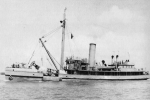NavSource Online:
Lighthouse Tender Photo Archive
USCGC Larkspur (WAGL 226)
Nan - Roger - Xray - Fox
ex-USLHT Larkspur
Nan - Able - Mike - Boy |
George - Vice - Pup - Mike |
Lighthouse Tender:
Specifications:
View the Larkspur
DANFS history entry located on the Naval History and Heritage Command website
| Back to the Main Photo Index | Back to the Lighthouse Tender Photo Index |
| Comments, Suggestions, E-mail Webmaster |
|
This page created by Joseph M. Radigan and maintained by David Wright |
